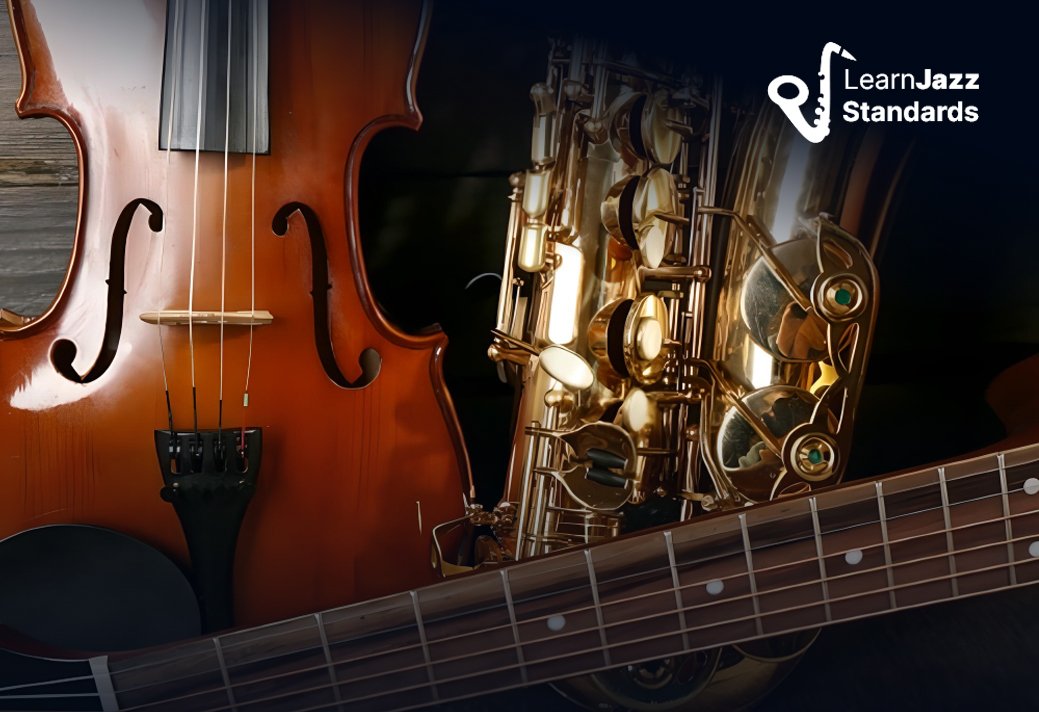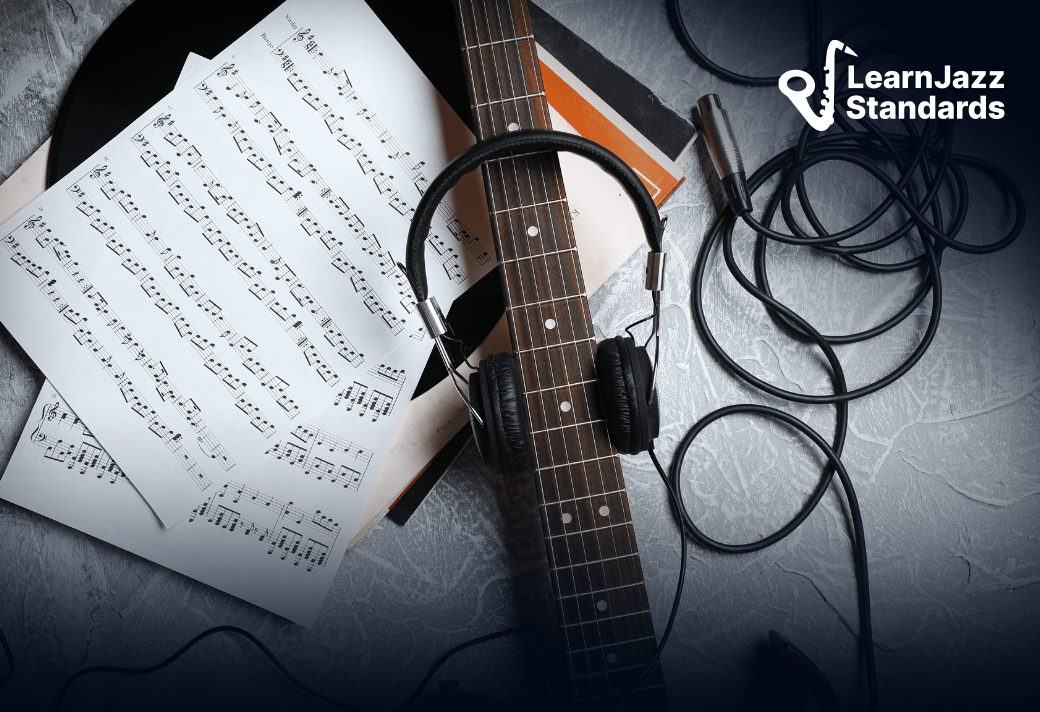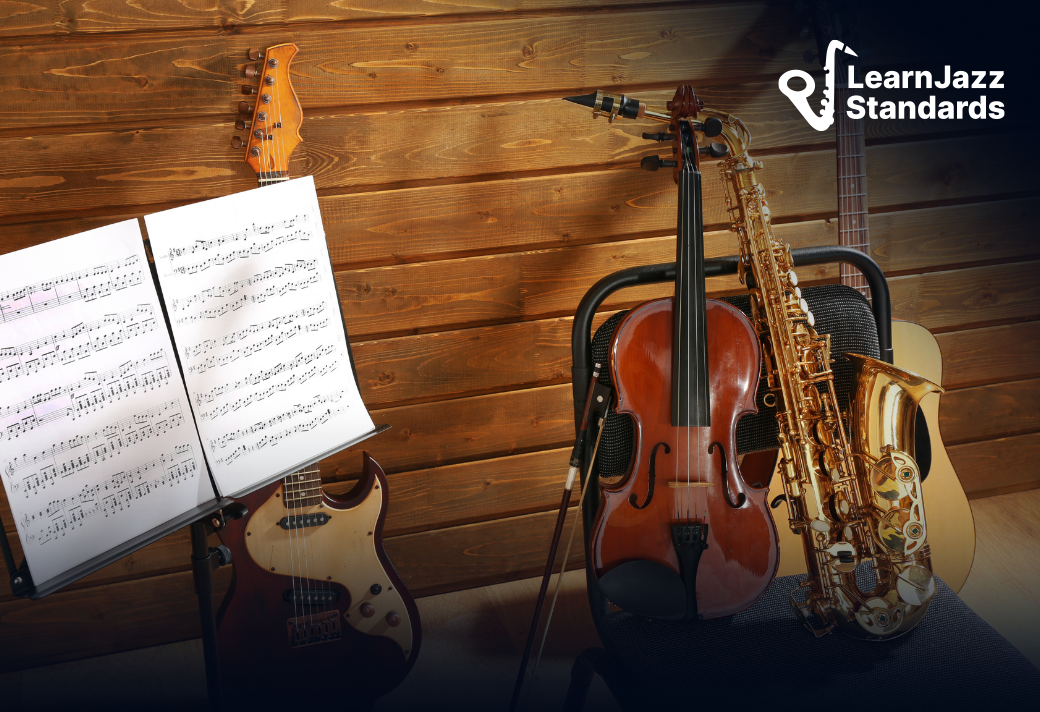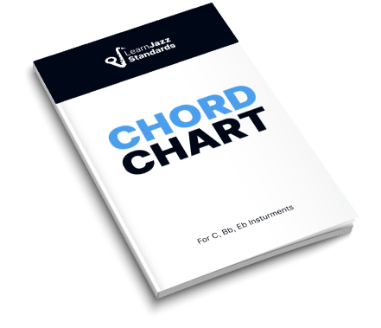Blues is one of the three key ingredients of jazz, and the blues chord progression is one of jazz’s most important song forms. So, if you want to understand the language of jazz, you’ll need first to internalize the sounds, rhythms, and colors.
And that involves mastering several forms of the blues progression.
In this post, we’ll take a crash course in all things blues, including the most important blues chord progressions you need to know to speak the language of jazz.
We’ll cover—
- The History of Blues
- How To Understand Blues Progressions Using Chord Numbers
- The 4 Most Important Blues Chord Progressions
- Other Essential Blues Chord Variations You Need To Know
- Extra Blues Chord Practice Resources and Blues Chord Practice Tips
- Classic Jazz Blues Songs and Essential Listening Recommendations Along The Way
If you want to join an avid community of like-minded lovers of jazz, then you need to check out the LJS inner circle. Our community is made up of musicians of all levels who share a common belief—that a journey in jazz education never stops.
We’re always learning and always hungry to learn more. If you want to join a positive jazz community and learn essential strategies for—
- Mastering jazz knowledge
- Strengthening your ear to hear jazz blues music
- Crafting breathtaking solos
- Excelling on your instrument…
…then you need to check out the LJS inner circle.
Table of Contents
- A Quick History of Blues Music
- Breaking Down Blues Songs: Understanding Blues Progressions Using Chord Numbers
- 1. Basic I7-IV7-V7 Blues Chord Progression
- 2. Basic Jazz Blues Chord Progression
- 3. Common Jazz Blues Chord Progression Additions
- 4. Bird Blues Chord Progression
- Even More Blues Progression Variations! (And Blues Songs to Check Out, Learn, and Practice Over)
- Resources for Practicing the Blues
A Quick History of Blues Music
As we mentioned above, one of the most important song forms in jazz is the blues, but before we dig into blues chord progressions, we’ll need to establish some historical context so we better understand the context of blues songs and what they mean to American history generally, and African American history specifically.
All modern blues music can be traced back to a pivotal point in American history—the enslavement of people of color. The blues was forged in the oppression of the working fields by people who were taken directly from Africa and forced into chattel slavery or who were born into slavery in the Southern United States or the Caribbean.
These enslaved people had strong African music traditions, including spiritual and work songs. These were further filtered through the musical traditions of the Caribbean to produce an African-American music tradition with a unique sound that took off in popularity with the rise of the recording industry in the 1920s.
This early version of the blues shares a few key characteristics with most blues songs today:
- Often, there was a “call and response” element
- There was a stress on repetition and rhythm, which would eventually evolve into the blues rhythm or shuffle rhythm.
- Melodies could be microtonal, eventually leading to the blues scale with its “blue note.”
Where Does Blues Music Fit Into Jazz Music?
Early jazz was born in the diverse port city of New Orleans, and the blues was one of the key ingredients, along with syncopated rhythms and swing.
The blues chord progressions we know today are usually 12-bar blues progression in common (4/4) time. However, when jazz musicians play the blues, you’ll find blues songs with different variations and different time signatures.
Though the basic blues chord progression is just three chords, jazz musicians often add many others and make crazy alterations. In this post, we will walk through 4 different important blues chord progressions and then get to some fun extras.
But first, we’ve got to understand how to comprehend the blues chord progression.
Breaking Down Blues Songs: Understanding Blues Progressions Using Chord Numbers
When it comes to jazz improvisation, I have a special rule:
If you want to become a great jazz improviser, you must understand jazz harmony.
In other words, you could learn all of the licks and tricks you want, but if you don’t know how jazz harmony works, you won’t ever truly get it. That’s why it’s important to identify chord progressions and understand how they move.
When discussing the blues chord progression and its common variations, we will deal with chords by numbers. Specifically, we’ll use roman numerals to outline each chord’s relationship to the key’s tonal center.
One thing to note is that when understanding blues chord progressions by numbers, the diatonic series does not always represent the same quality you would see from the major diatonic series.
Normally, in the major diatonic series, the I and IV chords are both major 7th chords (Imaj7 and IVmaj7). The V7 chord is the only dominant quality chord in the major diatonic series.
But in most blues songs, the I chord and the IV chord are still major chords, but they are dominant. This means the 7th scale degree, which is normally a major 7th interval, is lowered by a half step and becomes a minor 7th interval. This small change to these two chords is crucial to the unique sound of blues chord progressions.
You’ll see a I7 and a IV7 instead of Imaj7 or IVmaj7.
For example, the I chord and IV chords are dominant.

I7 – VI7 in Bb
Let’s review these important blues forms, starting with the Basic I7-IV7-V7.
1. Basic I7-IV7-V7 Blues Chord Progression

Basic Blues Progression in Bb
This blues form is a basic 12-bar blues, utilizing three basic blues chords: I7, IV7, and the V chord:
- I7
- IV7
- V7
I have this lead sheet in concert Bb, as this is one of jazz’s most popular keys for blues progressions. Take some time to memorize this chord progression because this is important to know! If you have trouble memorizing chord progressions, break the 12-bar blues progression into sections of four bars.
If you play a chordal instrument such as piano or guitar, be sure you can comp through this and play all of the dominant 7th chords. If you are a horn player or other instrumentalist, be able to play arpeggios over the dominant 7th chords. (Be sure you can do it in other keys, too!)
It’s also important to note that blues and rock music often use the same form, but the musicians sometimes use regular major chords instead of dominant 7th chords. However, the blues form remains the same.
Now let’s go over the Basic Blues. Jazz musicians have taken the basic blues chords and added more chord changes and variations. Many jazz blues standards are written with these changes.
2. Basic Jazz Blues Chord Progression
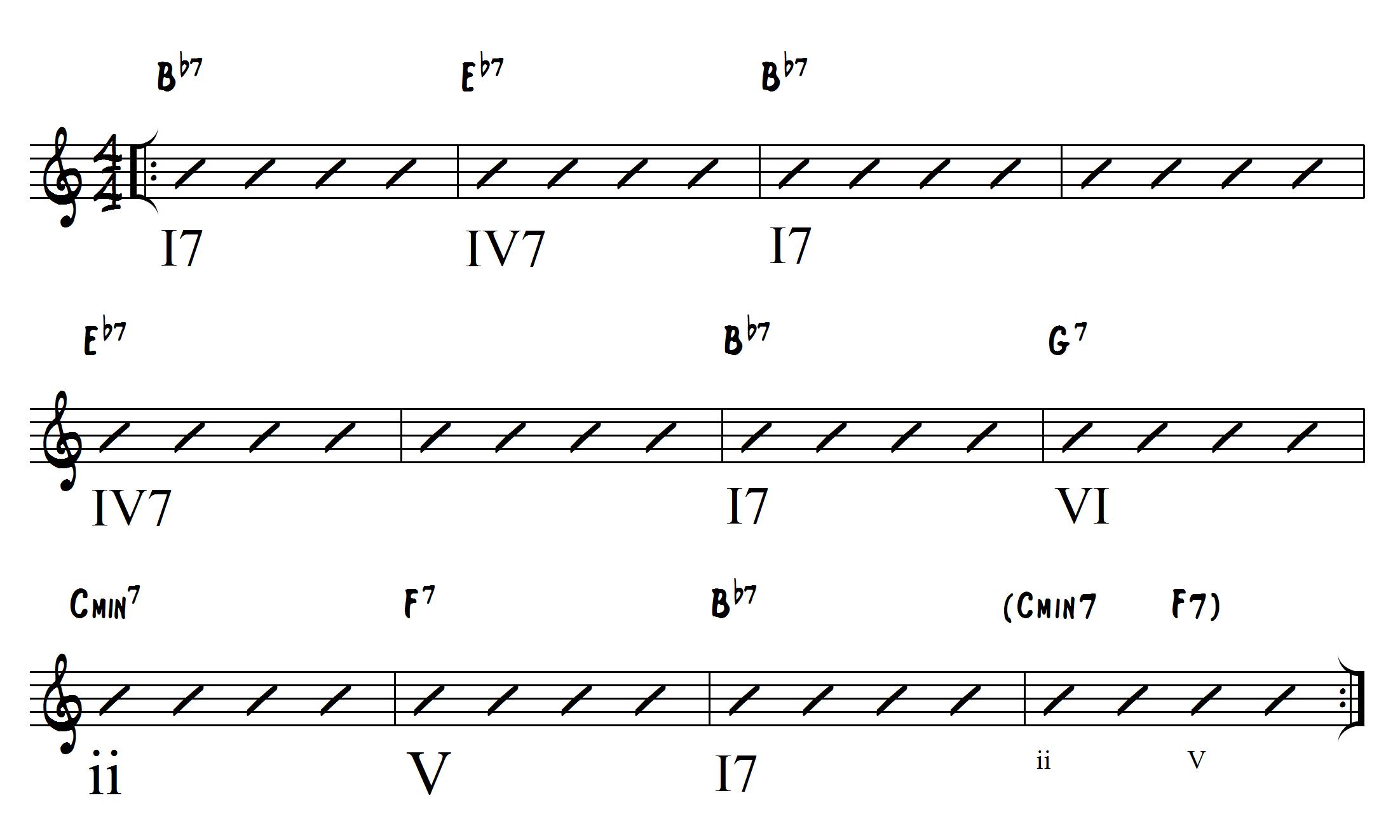
Basic Jazz Blues Chord Progression in Bb (with some added changes)
Basic blues chords: I7, IV7, and V7
The differences in the chord changes start in bar 8. Instead of going to the V chord in bar 9, they play a ii-V into the I7 chord in bar 11. To bridge the gap from the Bb7 in bar 7, the dominant VI chord is added in bar 8.
You may have noticed the chord in parenthesis in the Basic I7-IV-V Blues, and now you see it again in the Basic Jazz Blues (C7-F7).
This is what we call a turnaround. The blues is a short form repeated many times throughout a song. To get from the end back to the beginning, you can add a turnaround, such as a ii-V, to get back to the top.
Now, jazz musicians get bored easily. They like to add even more changes to the blues. There are a lot of possibilities for adding and re-harmonizing this chord progression, but there are certain additions to the blues, in particular, that jazz musicians like to use.
BEFORE YOU CONTINUE...
If music theory has always seemed confusing to you and you wish someone would make it feel simple, our free guide will help you unlock jazz theory secrets.

3. Common Jazz Blues Chord Progression Additions
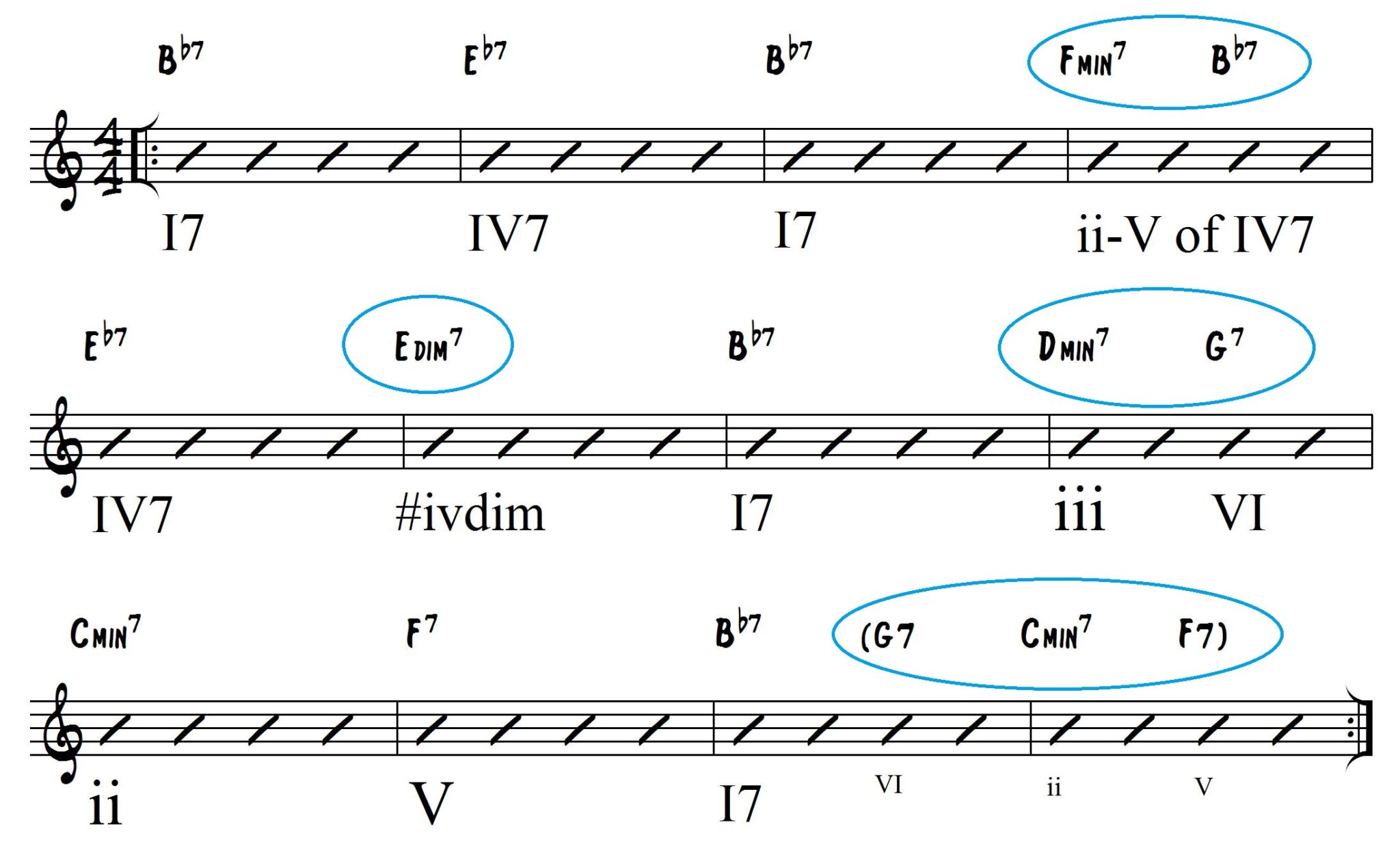
Bb Jazz Blues Progression with even more changes
In bar 4, a ii-V of IV7 is added, meaning that you can perceive the Fmin7-Bb7 as a ii-V- into Eb7. This makes it easier to think about rather than relating these chords to the parent key center of Bb.
In bar 6, the #iv diminished is added.
In bar 8, the iii chord is added with the VI. This adds some nice voice leading into the ii chord.
The turnaround at the end now has a VI chord added in bar 11. Essentially, bars 11 and 12 are a I-VI-ii-V chord progression.
4. Bird Blues Chord Progression
There is one more kind of jazz blues you should know. It’s called a Bird Blues. Sometimes it’s also called a “Bebop Blues.”
Bird refers to Charlie Parker, the iconic saxophonist who pioneered Bebop. If you don’t know who he is, look him up! His nickname was “Bird,” hence “Bird Blues.” He took the 12-bar blues and re-harmonized it using different chord qualities to make his own version of the blues.
A good example is his tune, Blues for Alice.
His version of the blues is straight out of the bebop tradition. There are lots of chord changes and reharmonized chords. Below, you’ll see a Bird Blues with the basic blues chords circled to see the original song form.
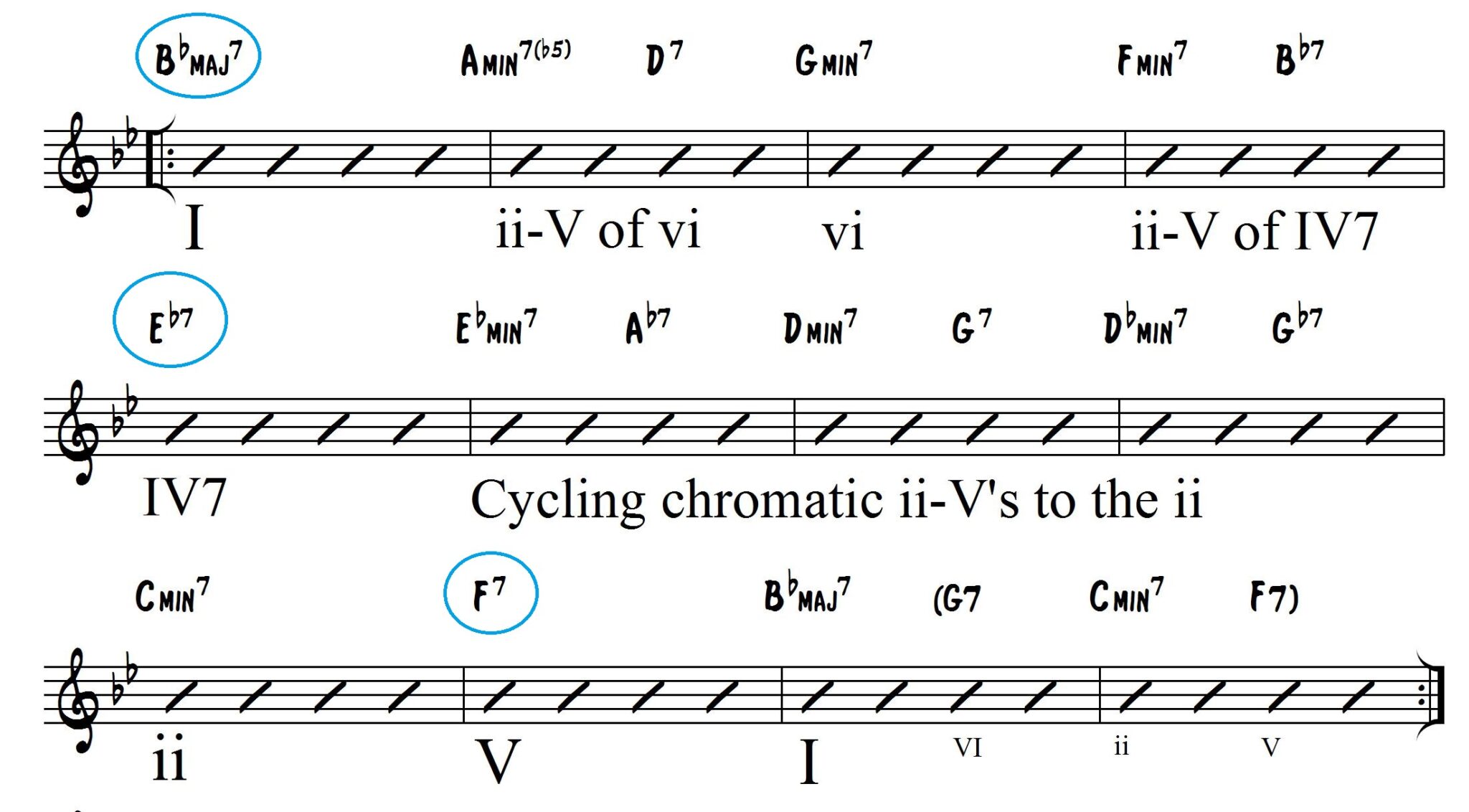
Bird Blues Chord Progression in Bb
Circled are the I, IV, and V chords. Those are the three chords in the Basic I7-IV7-V Blues, although Parker changed the I7 chord into a Imaj7 chord. Charlie Parker added all the changes in between to lead to those chords. We call these chords target chords. They are being targeted by other progressions that eventually resolve back to those basic blues chords.
The ii-V of vi is a detour that leads into the ii-V of IV7.
The series of cycling chromatic ii-V’s leads into the ii (C-7), which leads into the V (F7).
Even More Blues Progression Variations! (And Blues Songs to Check Out, Learn, and Practice Over)
Here are some jazz tune examples that take the blues progression and change it to explore new sounds. The following blues songs are strong examples of jazz musicians who pushed the standard blues in different directions.
Some of these blues songs will use familiar basic blues chords, while others might veer off into more experimental (or non-traditional) blues chord progressions.
The Minor Blues Progression—John Coltrane’s “Equinox”
The minor blues is a fun variation of the regular blues progression. The basic structure remains the same: it’s still 12 bars based around 4-bar phrasing and still hits the same chords. However, instead of using dominant 7th chords for the I7 and the IV7, it uses minor 7th chords.
From the first chord, the result is that we get a darker sound. We use a i-7, iv-7, but the V7 chord is still a dominant 7th chord. Notice in John Coltrane’s “Equinox,” the chord changes are slightly different.
For the first four bars, we stay on the minor i chord. For the second four bars, we move to the minor vi chord and then back to the minor i chord. However, check out the big difference in bar 9. Before we hit the V chord, we go to a flat VI7 chord. We haven’t seen this yet in any blues progression we’ve looked at.
This bVI7 chord in bar 9 is a common variation for the minor blues progression.
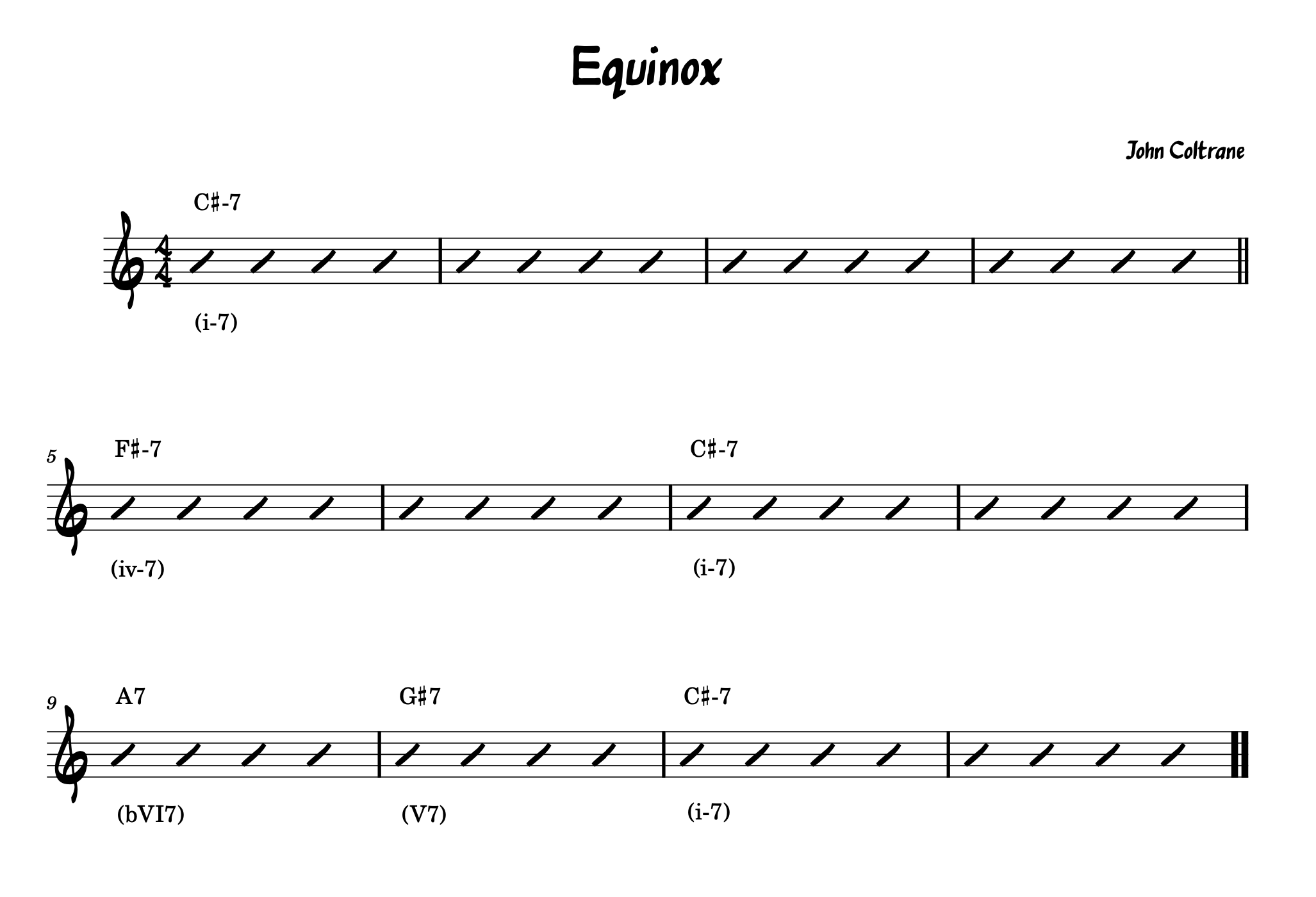
Blues Chords: John Coltrane’s Equinox, a minor blues in C#-
Ornette Coleman’s “Turnaround”
Some jazz artists like to take the familiar and change them drastically. Ornette Coleman was a jazz artist who always wrote songs with an avant-garde twist. One of the tamer examples of this is his blues head “Turnaround.”
For the first 8 bars, it’s a standard jazz blues in the key of C. But instead of going to the V chord in bar 9, as you’d expect. Ornette instead plays a C-7 chord or an i-7 chord, which he moves up a half step to Db-7. In the 10th bar, he takes the minor 7th down in whole steps to B-7 and, finally, to A-7 before landing on the I7 chord in bar 11.
This is an example of parallel harmony (where you take the same chord quality and move it around a bunch).
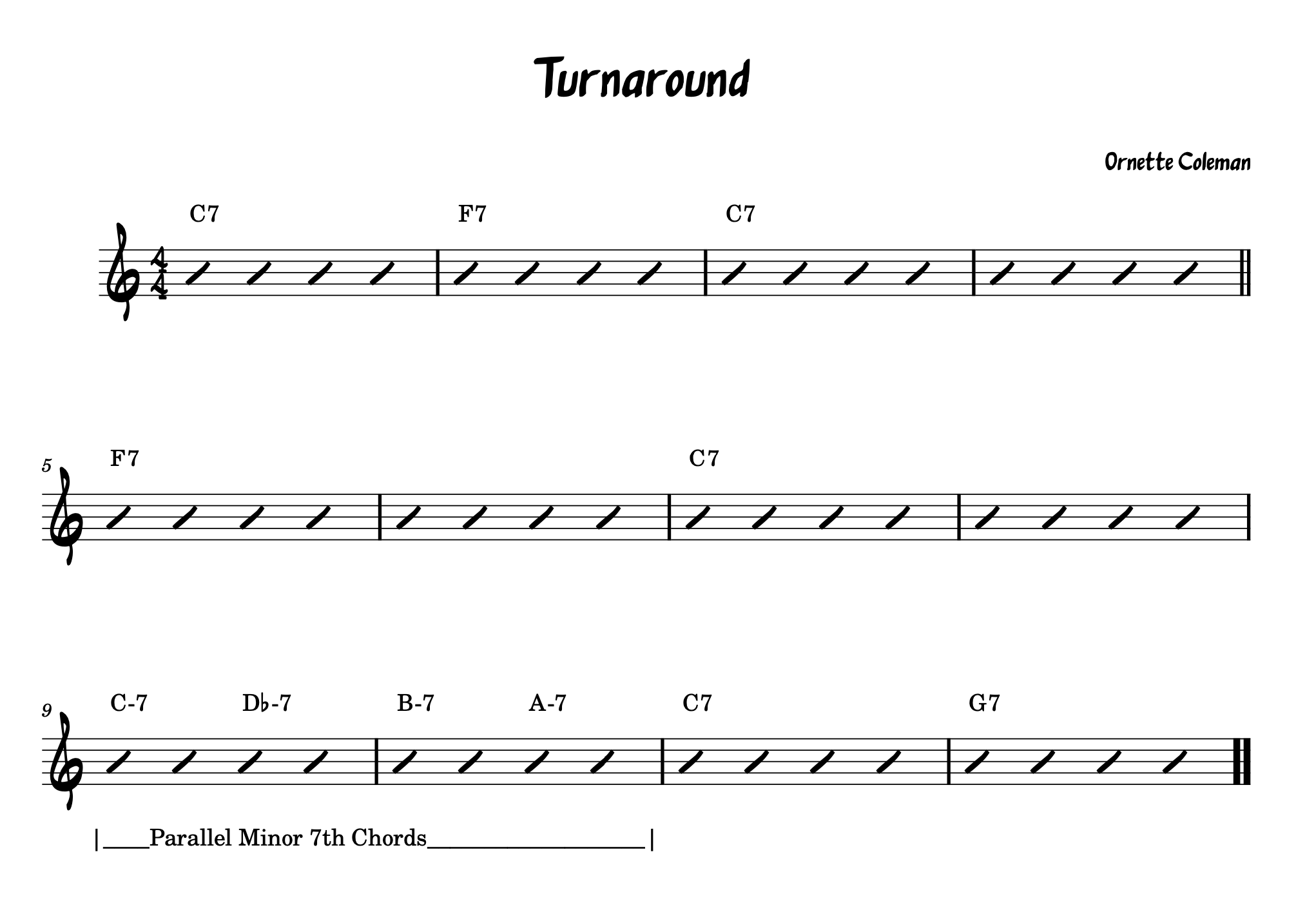
Ornette Coleman’s Turnaround; check out the parallel minor 7th chords.
To learn dominant guitar chords and voicings, check out our post on dominant guitar chords.
“All Blues:” A Variation on the Blues in 6/8 Time
Despite all the varieties of the blues progression we’ve explored so far, every example has been in 4/4 or common time. However, many jazz composers tire of writing and playing music in 4/4!
Miles Davis was one of these composers, and his tune “All Blues” is a blues form written in 6/8 time. Miles chose 6/8 time instead of 3/4 to keep the 12-bar blues form. Otherwise, it would have been a 24-bar blues!
In addition to changing the time signature, he throws in the bVI7 chord common in the minor blues into bar 10 of the form.
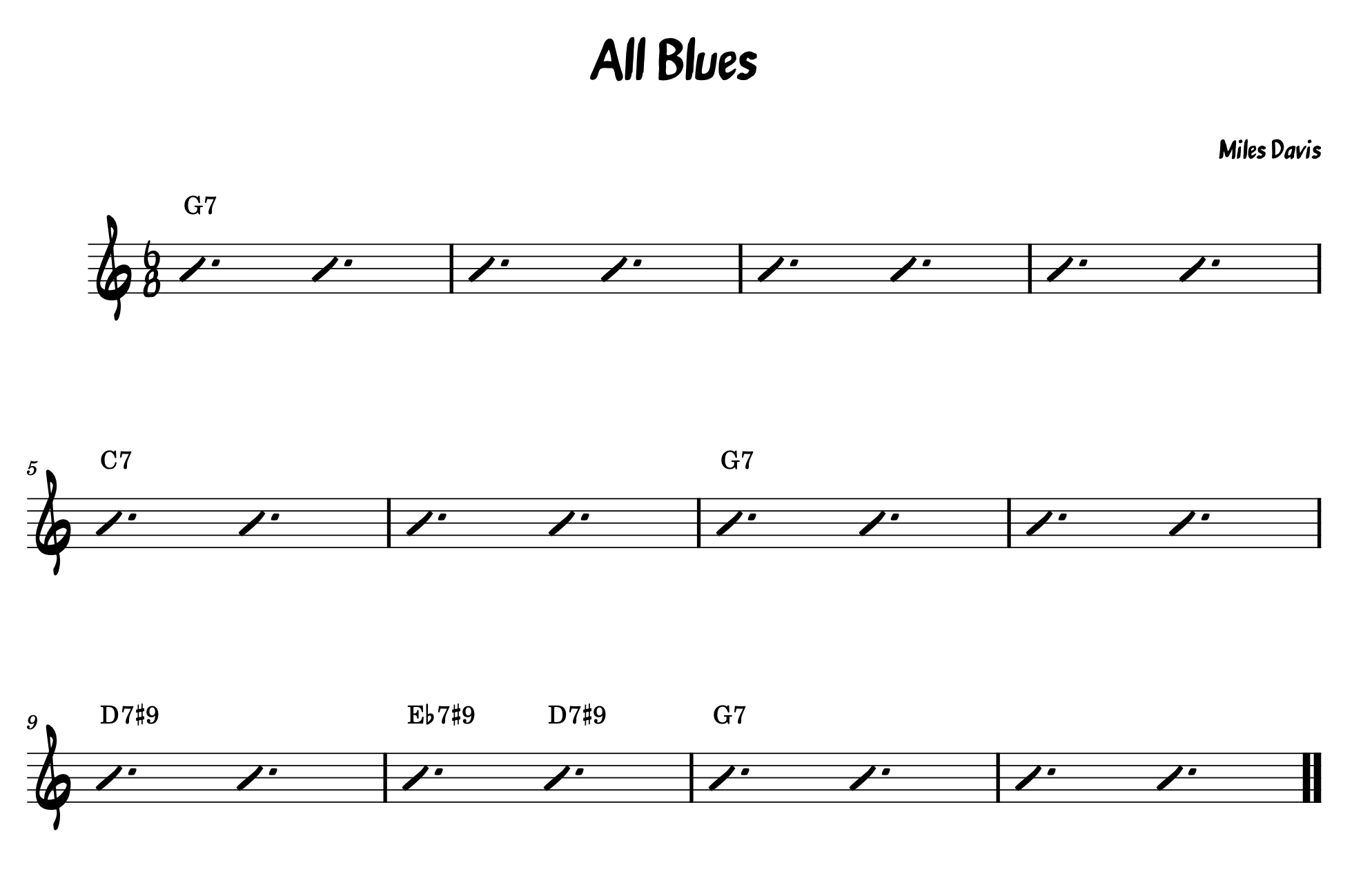
Mile’s Davis’s All Blues
For more on jazz harmony, check out our post on how jazz musicians create harmonic movement.
Resources for Practicing the Blues
Understanding the construction and harmonic movement of the blues is important, but to fully experience a jazz blues, you’ll need to start improvising over it. Whether you play acoustic guitar, piano, trumpet, or saxophone, the following tips will help you get started improvising over the chord structure of the blues.
Here are some practicing tips for developing a strong jazz feel while playing over the 12-bar blues progression:
Whether you play a chordal or melodic instrument, be sure to practice different blues heads in different keys. Playing heads in different keys will open up many pathways and connections that will improve your soloing. Plus, being able to play on a blues in any given key is an important jam session skill to develop!
Try practicing playing through a head or comping through the changes with a metronome on beats 2 and 4. After that feels good, try it just on beat 2. This challenge forces you to fill in the missing rhythmic information and will improve your time feel.
The earliest blues song was sung. Try singing a solo over the blues to test whether or not you have internalized various pitch relationships to the I, IV, V, and other blues chords that appeared in this post. It’s also a great way to test your jazz vocabulary (off your instrument).
Learn blues chord comping rhythms if you play blues rhythm guitar or blues piano. Blues rhythm guitar and blues piano share a lot of rhythmic similarities. Listen to your favorite jazz guitarists and pianists comp over a 12-bar blues and transcribe what you hear! Then apply it to different keys.
Try playing blues scales over a 12-bar blues progression and compare it to the bebop dominant scale.
Blues Scale:

Bebop Dominant Scale:

Start Playing Blues Like a Pro! Join the Inner Circle
Join the LJS Inner Circle and network with jazz musicians who love jazz and jazz blues as much as you do! Inner Circle Members also have access to our Jazz Blues Accelerator course.
If you want to get serious about improving your jazz playing skills and take actionable, measurable steps toward harmonic and melodic mastery, you need to see for yourself and check out what the LJS Inner Circle is about.


